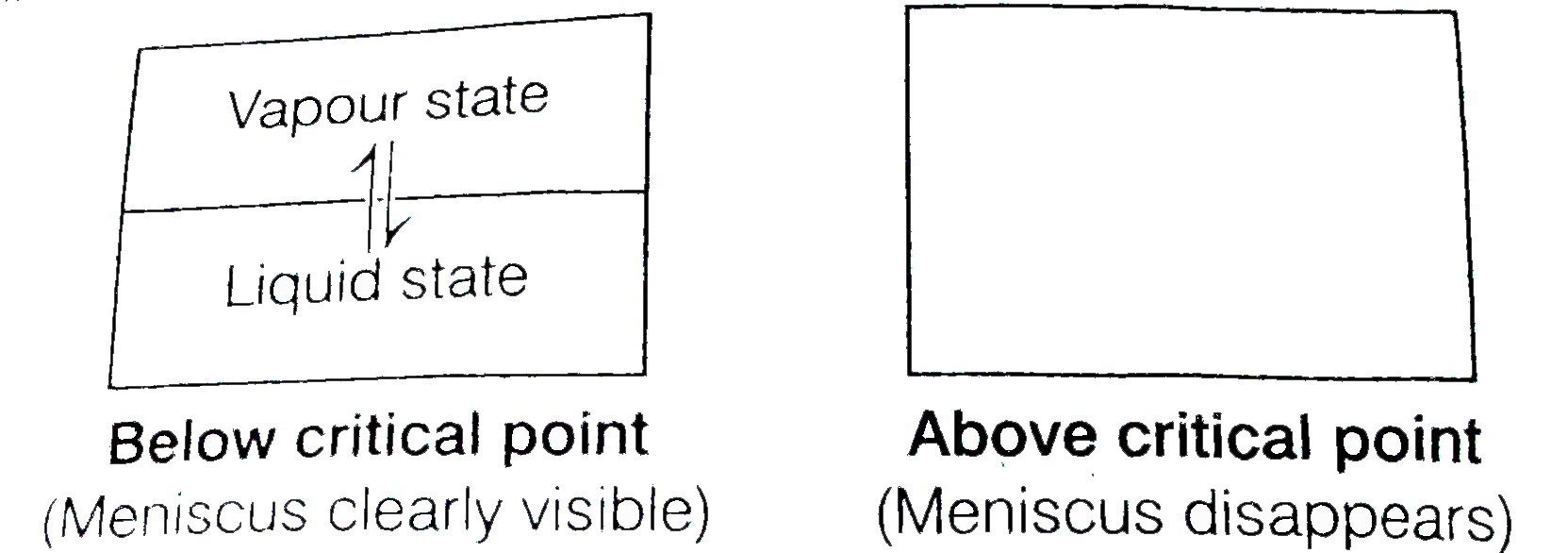Why does the boundary between liquid phase and gaseous phase disappear on heating a liquid upto critical temperature in a closed vessel ? In this situation what will be the state of the substance ?
In a closed vessel, it is essential to know that below the critical point (i.e., critical temperature and critical pressure), the surface of separation between the liquid and its vapour is clearly visible. As we approach towards the critical point, the density of the liquid decreases while that of the vapour increases due to compression.

At the critical point, the densities of the liquid and that of the vapour becomes equal and the surface of separation disappears i.e., the liquid and the gaseous state become not separable. In other words, the meniscus is no longer visible.
The fluid which is now a homogeneous mixture is called supercritical fluid. Hence, any fluid above its critical temperature and pressure is called is called a supercritical fluid.
These supercritical fluids dissolve many organic substances. they are used for quick separation of a mixture into its components. e.g., CO2 above 31.1∘C and above 600 bar pressure has a density of about 1g/cm3.
It is used to issolve out caffeine from coffee beans as it is a better substitute than chlorofluorocarbons which are harmful for the environment.
Topper's Solved these Questions
- STATES OF MATTERBOOK - NCERT EXEMPLARCHAPTER - STATES OF MATTEREXERCISE - Assertion and Reason
6 Videos
- SOME BASIC CONCEPTS OF CHEMISTRYBOOK - NCERT EXEMPLARCHAPTER - SOME BASIC CONCEPTS OF CHEMISTRYEXERCISE - All Questions
45 Videos
- STRUCTURE OF ATOMBOOK - NCERT EXEMPLARCHAPTER - STRUCTURE OF ATOMEXERCISE - All Questions
53 Videos
Similar Questions
Knowledge Check
When density of liquid and vapours becomes the same the clear boundary between liquid and vapours disappear the temperature is called
ABoyle's temperatureBmelting pointCcritical temperatureDnone of the aboveWhen density of liquid and vapours becomes the same the clear boundary between liquid and vapours disappear the temperature is called
ABoyle's temperatureBmelting pointCcritical temperatureDnone of the aboveThe amount of heat required to change a liquid to gaseous state without any change in temperature is known as
Aspecific heat capacityBmechanical equivalent of heatClatent heat of vaporizationDquenching
What happens if a liquid is heated to the critical temperature of its vapour?
View SolutionWhat is the nature of equilibrium between the liquid surface and its vapours in a closed vessel ?
View SolutionA substance is in liquid state at room temperature and changes into gaseous state upon heating. What will you call its gaseous state ?
View SolutionEach phase of a material can exits only in certain regions of pressure and temperature . P−T phase diagrams, in which pressure is plotted versus temperature, show the regions corresponding to various phases and phase transformations . P−V diagrams, on the other hand , can be used to study pressure volume relationship at a constant temperature.
If the liquid and gaseous phases of a pure substances are heated together in a closed container, both the temperature and the vapor pressure will increase until a point is reached at which the two phases can no longer be distinguished from one another. The temperature and pressure at which this occurs are called the critical temperature and pressure. Exceeding either of these parameters, by itself ,will cause the gas/liguid phase transition to disappear. if the other variable is then changed as well, while the first variable is maintained above its critical point , a gradual transition will occur between the gaseous and liquid phases, with no clear boundary.(The liquid and solid phases, on the other hand , maintain a distinct boundary at all pressure above the triple point). Shown in figure is a combined P−T phase diagram for material A and B.
_E01_196_Q01.png)
Which is true about the substance in figure?
View SolutionEach phase of a material can exits only in certain regions of pressure and temperature . P−T phase diagrams, in which pressure is plotted versus temperature, show the regions corresponding to various phases and phase transformations . P−V diagrams, on the other hand , can be used to study pressure volume relationship at a constant temperature.
If the liquid and gaseous phases of a pure substances are heated together in a closed container, both the temperature and the vapor pressure will increase until a point is reached at which the two phases can no longer be distinguished from one another. The temperature and pressure at which this occurs are called the critical temperature and pressure. Exceeding either of these parameters, by itself ,will cause the gas/liguid phase transition to disappear. if the other variable is then changed as well, while the first variable is maintained above its critical point , a gradual transition will occur between the gaseous and liquid phases, with no clear boundary.(The liquid and solid phases, on the other hand , maintain a distinct boundary at all pressure above the triple point). Shown in figure is a combined P−T phase diagram for material A and B.
_E01_195_Q01.png)
If heat is added to solids A and B , each in a container that is open to the atmosphere :-
View Solution
